Multi-Year (2013–2016) PM2.5 Wildfire Pollution Exposure over North America as Determined from Operational Air Quality Forecasts
Abstract
:1. Introduction
2. Methodology
2.1. North American Wildfire AQ Forecasting System
2.2. Wildfire Emissions’ Contribution to PM2.5 Pollution
2.3. Population Exposure Estimation
2.4. Exposure Frequency Estimation
3. Results
3.1. Area Affected by Wildfire Smoke
3.2. Population Exposure to Wildfire Pollution
3.3. Frequency of Wildfire-Related Pollution Events
4. Discussion
5. Conclusions
Supplementary Materials
Acknowledgments
Author Contributions
Conflicts of Interest
References
- Beverly, J.L.; Bothwell, P. Wildfire evacuations in Canada 1980–2007. Nat. Hazards 2011, 59, 571–596. [Google Scholar] [CrossRef]
- Canadian Interagency Forest Fire Centre. Canada Report 2016. Available online: http://www.ciffc.ca/images/stories/pdf/2016_canada_report_2017_05_15_v02.pdf (accessed on 15 May 2017).
- Natural Resources Canada. Cost of Fire Protection. Available online: http://www.nrcan.gc.ca/forests/climate-change/forest-change/17783 (accessed on 15 May 2017).
- Flannigan, M.; Tymstra, C. The Fort McMurray Wildfire: By the Numbers. Canadian Wildland Fire & Smoke Newsletter. 2016; pp. 1–2. Available online: https://sites.ualberta.ca/~wcwfs/CWFSN/newsletters/CWFSN_Fall_2016.pdf (accessed on 15 September 2017).
- Urbanski, P.U.; Hao, W.M.; Baker, S. Chemical composition of wildland fire emissions. Dev. Environ. Sci. 2009, 8, 79–107. [Google Scholar]
- Reid, C.E.; Brauer, M.; Johnston, F.H.; Jerrett, M.; Balmes, J.R.; Elliott, C.T. Critical Review of Health Impacts of Wildfire Smoke Exposure. Environ. Health Perspect. 2016, 124, 1334–1342. [Google Scholar] [CrossRef] [PubMed]
- Liu, J.C.; Pereira, G.; Uhl, S.A.; Bravo, M.A.; Bell, M.L. A systematic review of the physical health impacts from non-occupational exposure to wildfire smoke. Environ. Res. 2015, 136, 120–132. [Google Scholar] [CrossRef] [PubMed]
- Liu, J.C.; Mickley, L.J.; Sulprizio, M.P.; Dominici, F.; Yue, X.; Ebisu, K.; Anderson, G.B.; Khan, R.F.; Bravo, M.A.; Bell, M.L. Particulate air pollution from wildfires in the Western US under climate change. Clim. Chang. 2016, 138, 655–666. [Google Scholar] [CrossRef] [PubMed]
- Thurston, G.D.; Kipen, H.; Annesi-Maesano, I.; Balmes, J.; Brook, R.D.; Cromar, K.; de Matteis, S.; Forastiere, F.; Forsberg, B.; Frampton, M.W.; et al. A joint ERS/ATS policy statement: What constitutes an adverse health effect of air pollution? An analytical framework. Eur. Respir. J. 2017, 49, 1600419. [Google Scholar] [CrossRef] [PubMed]
- Canadian Council of Ministers of the Environment (CCME). Guidance Document on Achievement Determination Canadian Ambient Air Quality Standards for Fine Particulate Matter and Ozone. 2012; p. 43. Available online: http://www.ccme.ca/files/Resources/air/aqms/pn_1483_gdad_eng.pdf (accessed on 15 May 2017).
- Sapkota, A.; Symons, J.; Kleissl, J.; Wang, L.; Parlange, M.; Ondov, J.; Breysse, P.N.; Diette, G.B.; Eggleston, P.A.; Buckley, T.J. Impact of the 2002 Canadian forest fires on particulate matter air quality in Baltimore city. Environ. Sci. Technol. 2005, 39, 24–32. [Google Scholar] [CrossRef] [PubMed]
- Forster, C.; Wandinger, U.; Wotawa, G.; James, P.; Mattis, I.; Althausen, D.; Simmonds, P.; O’Doherty, S.; Jennings, I.M.; Kleefeld, C.; et al. Transport of boreal forest fire emissions from Canada to Europe. J. Geophys. Res. 2001, 106, 22887–22906. [Google Scholar] [CrossRef]
- Adam, M.; Pahlow, M.; Kovalev, V.A.; Ondov, J.M.; Parlange, M.B.; Nair, N. Aerosol optical characterization by nephelometer and lidar: The Baltimore Supersite experiment during the Canadian forest fire smoke intrusion. J. Geophys. Res. 2004, 109, D16. [Google Scholar] [CrossRef]
- Colarco, P.R.; Schoeberl, M.R.; Doddridge, B.G.; Marufu, L.T.; Torres, O.; Welton, E.J. Transport of smoke from Canadian forest fires to the surface near Washington, DC: Injection height, entrainment, and optical properties. J. Geophys. Res. 2004, 109, 1–12. [Google Scholar] [CrossRef]
- Spichtinger, N.; Wenig, M.; James, P.; Wagner, T.; Platt, U.; Stohl, A. Satellite detection of a continental-scale plume of nitrogen oxides from boreal forest fires. Geophys. Res. Lett. 2001, 28, 4579–4582. [Google Scholar] [CrossRef]
- Morris, G.A.; Hershey, S.; Thompson, A.M.; Stohl, A.; Colarco, P.R.; McMillan, W.W.; Warner, J.; Johnson, B.J.; Witte, J.C.; Kucsera, T.L.; et al. Alaskan and Canadian forest fires exacerbate ozone pollution in Houston, Texas, on 19 and 20 July. J. Geophys. Res. 2004, 111, 1–10. [Google Scholar] [CrossRef]
- DeBell, L.J.; Talbot, R.W.; Dibb, J.E.; Munger, J.W.; Fischer, E.V.; Frolking, S.E. A major regional air pollution event in the northeastern United States caused by extensive forest fires in Quebec, Canada. J. Geophys. Res. 2004, 109, 1–16. [Google Scholar] [CrossRef]
- Fiore, A.M.; Pierce, R.B.; Dickerson, R.R.; Lin, M.; Bradley, R. Detecting and attributing episodic high background ozone events. J. Air Waste Manag. Assoc. 2014, 64, 22–28. [Google Scholar]
- Dreessen, J.; Sullivan, J.; Delgado, R. Observations and impacts of transported Canadian wildfire smoke on ozone and aerosol air quality in the Maryland region on June 9–12. J. Air Waste Manag. Assoc. 2016, 66, 842–862. [Google Scholar] [CrossRef] [PubMed]
- Cottle, P.; Strawbridge, K.; McKendry, I. Long-range transport of Siberian wildfire smoke to British Columbia: Lidar observations and air quality impacts. Atmos. Environ. 2014, 90, 71–77. [Google Scholar] [CrossRef]
- Teakles, A.D.; So, R.; Ainslie, B.; Nissen, R.; Schiller, C.; Vingarzan, R.; McKendry, I.; Macdonald, A.M.; Jaffe, D.A.; Bertram, A.K.; et al. Impacts of the July 2012 Siberian fire plume on air quality in the Pacific Northwest. Atmos. Chem. Phys. 2017, 17, 2593–2611. [Google Scholar] [CrossRef]
- Centre for Disease Control. Evidence Review: Exposure Measures for Wildfire Smoke Surveillance. 31 March 2014. Available online: http://www.bccdc.ca/resource-gallery/Documents/Guidelines%20and%20Forms/Guidelines%20and%20Manuals/Health-Environment/WFSG_EvidenceReview_Smokesurveillance_FINAL_v2_edstrs.pdf (accessed on 15 May 2017).
- Rappold, A.G.; Reyes, J.; Pouliot, G.; Cascio, W.E.; Diaz-Sanchez, D. Community Vulnerability to Health Impacts of Wildland Fire Smoke Exposure. Environ. Sci. Technol. 2017, 51, 6674–6682. [Google Scholar] [CrossRef] [PubMed]
- Zhang, Y.; Bocquet, M.; Mallet, V.; Seigneur, C.; Baklanov, A. Real-time air quality forecasting, part I: History, techniques, and current status. Atmos. Environ. 2012, 60, 632–655. [Google Scholar] [CrossRef]
- Zhang, Y.; Bocquet, M.; Mallet, V.; Seigneur, C.; Baklanov, A. Real-time air quality forecasting, part II: State of the science, current research needs, and future prospects. Atmos. Environ. 2012, 60, 656–676. [Google Scholar] [CrossRef]
- Larkin, N.K.; O’Neill, S.M.; Solomon, R.; Raffuse, S.; Strand, T.; Sullivan, D.C.; Krull, C.; Rorig, M.; Peterson, J.; Ferguson, S.A. The BlueSky smoke modeling framework. Int. J. Wildland Fire 2010, 18, 906–920. [Google Scholar] [CrossRef]
- Pavlovic, R.; Chen, J.; Anderson, K.; Moran, M.D.; Beaulieu, P.-A.; Davignon, D.; Cousineau, S. The FireWork air quality forecast system with near-real-time biomass burning emissions: Recent developments and evaluation of performance for the 2015 North American wildfire season. J. Air Waste Manage. Assoc. 2016, 66, 819–841. [Google Scholar] [CrossRef] [PubMed]
- Pavlovic, R.; Chen, J.; Davignon, D.; Moran, M.D.; Beaulieu, P.A.; Landry, H.; Sassi, M.; Gilbert, S.; Munoz-Alpizar, R.; Anderson, K.; et al. FireWork—A Canadian Operational Air Quality Forecast Model With Near-Real-Time Biomass Burning Emissions. Canadian Wildland Fire & Smoke Newsletter. 2016, pp. 18–29. Available online: https://sites.ualberta.ca/~wcwfs/CWFSN/newsletters/CWFSN_Fall_2016.pdf (accessed on 15 September 2017).
- Yuchi, W.; Yao, J.; McLean, K.E.; Stull, R.; Pavlovic, R.; Davignon, D.; Moran, M.D.; Henderson, S.B. Blending forest fire smoke forecasts with observed data can improve their utility for public health applications. Atmos. Environ. 2016, 145, 308–317. [Google Scholar] [CrossRef]
- Moran, M.D.; Ménard, S.; Pavlovic, R.; Anselmo, D.; Antonopoulos, S.; Makar, P.A.; Gong, W.; Stroud, C.; Zhang, J.; Zheng, Q.; et al. Recent advances in Canada’s National Operational AQ Forecasting System. In Proceedings of the 32nd NATO/SPS ITM on Air Pollution Modelling and Its Application, Utrecht, The Netherlands, 7–11 May 2012; pp. 215–220. [Google Scholar]
- Moran, M.; Zheng, Q.; Zhang, J.; Pavlovic, R. RAQDPS Version 013: Upgrades to the CMC Operational Regional Air Quality Deterministic Prediction System Released in June 2015. 2015; p. 57. Available online: http://collaboration.cmc.ec.gc.ca/cmc/cmoi/product_guide/docs/lib/op_systems/doc_opchanges/Technical_Note_GEM-MACH10_v1.5.3+SET2.1.1_Emissions_9Nov2015.pdf (accessed on 15 May 2017).
- Im, U.; Bianconi, R.; Solazzo, E.; Kioutsioukis, I.; Badia, A.; Balzarini, A.; Baro, R.; Bellasio, R.; Brunner, D.; Chemel, C.; et al. Evaluation of operational online-coupled regional air quality models over Europe and North America in the context of AQMEII phase 2. Part I: Ozone. Atmos. Environ. 2015, 115, 404–420. [Google Scholar] [CrossRef] [Green Version]
- Lee, B.S.; Alexander, M.E.; Hawkes, B.C.; Lynham, T.J.; Stocks, B.J.; Englefield, P. Information systems in support of wildland fire management decision making in Canada. Comput. Electron. Agric. 2002, 37, 185–198. [Google Scholar] [CrossRef]
- Anderson, K.R.; Englefield, P.; Little, J.M.; Reuter, G. An approach to operational forest fire growth predictions for Canada. Int. J. Wildland Fire 2009, 18, 893–905. [Google Scholar] [CrossRef]
- Moran, M.; Pavlovic, R.; Chen, J. FireWork 2016: Release of the Initial Operational Version of the CMC Regional Air Quality Deterministic Prediction System with Near-Real-Time Satellite-Derived Wildfire Emissions. 2016; p. 4. Available online: http://collaboration.cmc.ec.gc.ca/cmc/CMOI/product_guide/docs/tech_notes/technote_raqdps015fw_20160428_e.pdf (accessed on 15 May 2017).
- Kaiser, J.W.; Heil, A.; Andreae, M.O.; Benedetti, A.; Chubarova, N.; Jones, L.; Morcrette, J.-J.; Razinger, M.; Schultz, M.G.; Suttie, M.; et al. Biomass burning emissions estimated with a global fire assimilation system based on observed fire radiative power. Biogeosciences 2012, 9, 527–554. [Google Scholar] [CrossRef] [Green Version]
- Xing, J.; Pleim, J.; Mathur, R.; Pouliot, G.; Hogrefe Gan, C.-M.; Wei, C. Historical gaseous and primary aerosol emissions in the United States from 1990–2010. Atmos. Chem. Phys. 2013, 13, 7531–7549. [Google Scholar] [CrossRef]
- EPA. Draft Guidance for Comment: Significant Impact Levels for Ozone and Fine Particle in the Prevention of Significant Deterioration Permitting Program. 2016; p. 13. Available online: https://www.epa.gov/sites/production/files/2016-08/documents/pm2_5_sils_and_ozone_draft_guidance.pdf (accessed on 15 May 2017).
- Statistics Canada. Dissemination Areas, Census 2016. Available online: http://www12.statcan.gc.ca/census-recensement/2016/dp-pd/hlt-fst/pd-pl/Comprehensive.cfm (accessed on 15 May 2017).
- Statistics Canada. Boundary Files, Census 2016. Available online: http://www12.statcan.gc.ca/census-recensement/2011/geo/bound-limit/bound-limit-eng.cfm (accessed on 15 May 2017).
- United States Census Bureau. Census 2010. Available online: https://www.census.gov/geo/maps-data/data/tiger-data.html (accessed on 15 May 2017).
- National Intergancy Fire Center. Available online: https://www.nifc.gov/fireInfo/fireInfo_stats_totalFires.html (accessed on 15 May 2017).
- Jaffe, D.; Hafner, W.; Chand, D.; Westerling, A.; Spracklen, D. Interannual variations in PM2.5 due to wildfires in the Western United States. Environ. Sci. Technol. 2008, 42, 2812–2818. [Google Scholar] [CrossRef] [PubMed]
- Mao, Y.H.; Li, Q.B.; Zhang, L.; Chen, Y.; Randerson, J.T.; Chen, D.; Liou, K.N. Biomass burning contribution to black carbon in the Western United States Mountain Ranges. Atmos. Chem. Phys. 2011, 11, 11253–11266. [Google Scholar] [CrossRef] [Green Version]
- Spracklen, D.V.; Logan, J.A.; Mickley, L.J.; Park, R.J.; Yevich, R.; Westerling, A.L.; Jaffe, D.A. Wildfires drive interannual variability of organic carbon aerosol in the western U.S. in summer. Geophys. Res. Lett. 2007, 34, L16816. [Google Scholar] [CrossRef]
- Zeng, T.; Wang, Y. Nationwide summer peaks of OC/EC ratios in the contiguous United States. Atmos. Environ. 2011, 45, 578–586. [Google Scholar] [CrossRef]
- Henderson, S.B.; Johnston, F.H. Measures of forest fire smoke exposure and their associations with respiratory health outcomes. Curr. Opin. Allergy Clin. Immunol. 2012, 12, 221–227. [Google Scholar] [CrossRef] [PubMed]
- Dennekamp, M.; Straney, L.D.; Erbas, B.; Abramson, M.J.; Keywood, M.; Smith, K.; Sim, M.R.; Glass, D.C.; Monaco, A.D.; Haikerwal, A.; et al. Forest Fire Smoke Exposures and Out-of-Hospital Cardiac Arrests in Melbourne, Australia: A Case-Crossover Study. Environ. Health Perspect. 2015, 123, 959–964. [Google Scholar] [CrossRef] [PubMed]
- Johnston, F.H.; Henderson, S.B.; Chen, Y.; Randerson, J.T.; Marlier, M.; DeFries, R.S.; Kinney, P.; Bowman, D.M.; Brauer, M. Estimated Global Mortality Attributable to Smoke from Landscape Fires. Environ. Health Perspect. 2012, 120, 695–701. [Google Scholar] [CrossRef] [PubMed]
- Robichaud, A.; Ménard, R.; Zaïtseva, Y.; Anselmo, D. Multi-pollutant surface objective analyses and mapping of air quality health index over North America. Air Qual. Atmos. Health 2016, 9, 743–759. [Google Scholar] [CrossRef] [PubMed]
- Jolly, W.M.; Cochrane, M.A.; Freeborn, P.H.; Holden, Z.A.; Brown, T.J.; Williamson, G.J.; Bowman, D.M. Climate-induced variations in global wildfire danger from 1979 to 2013. Nat. Commun. 2015, 6, 7537. [Google Scholar] [CrossRef] [PubMed]
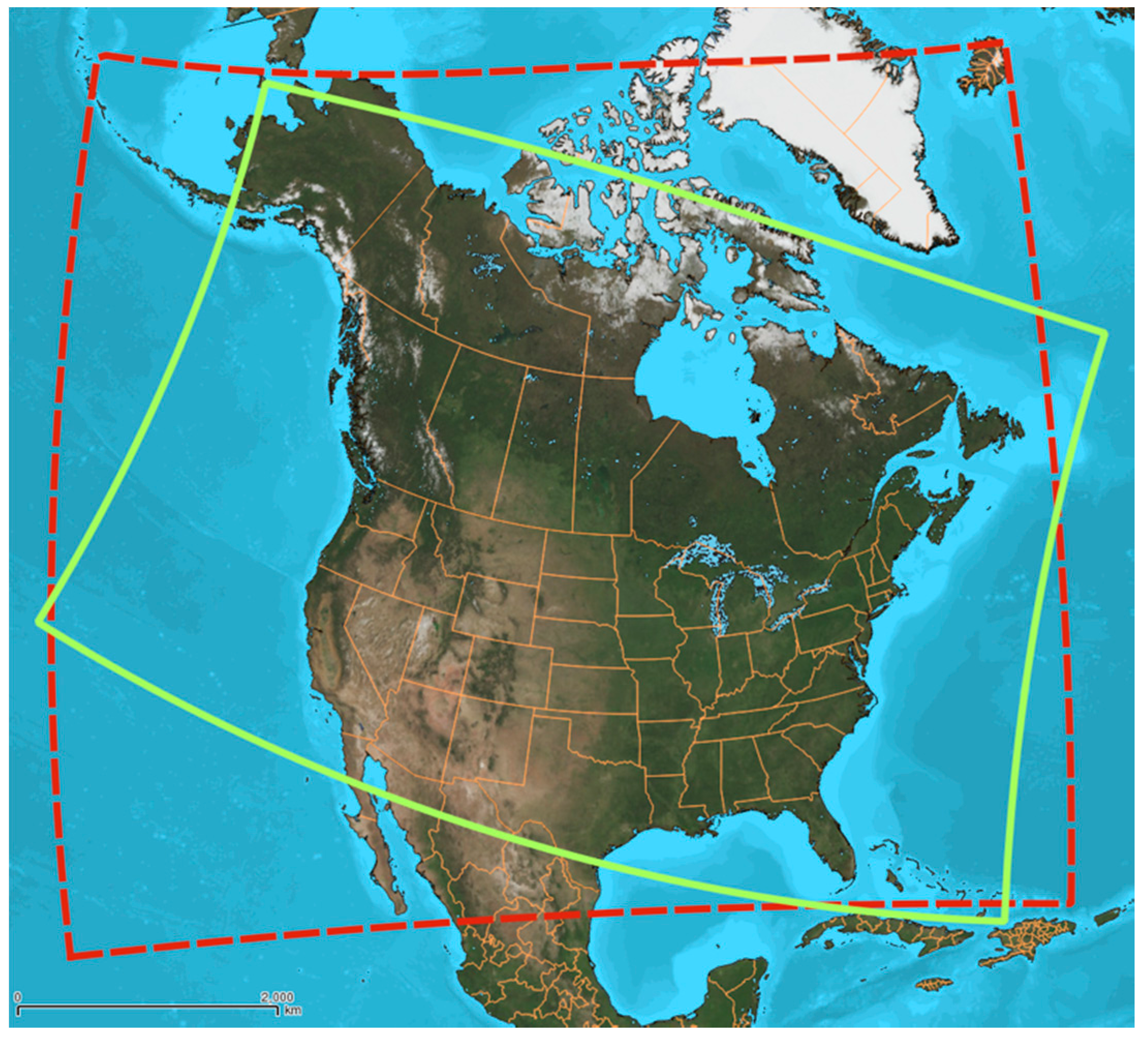
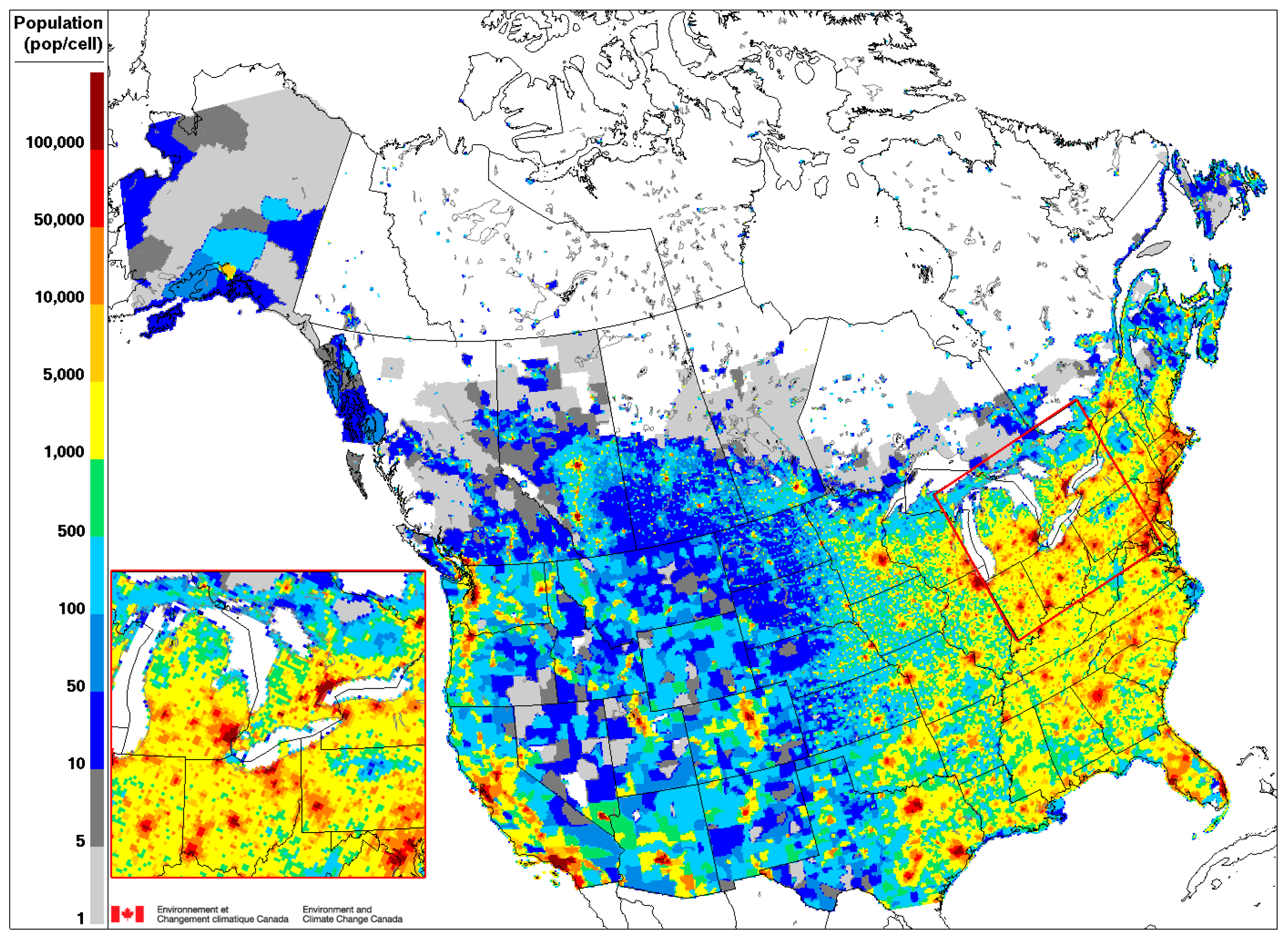


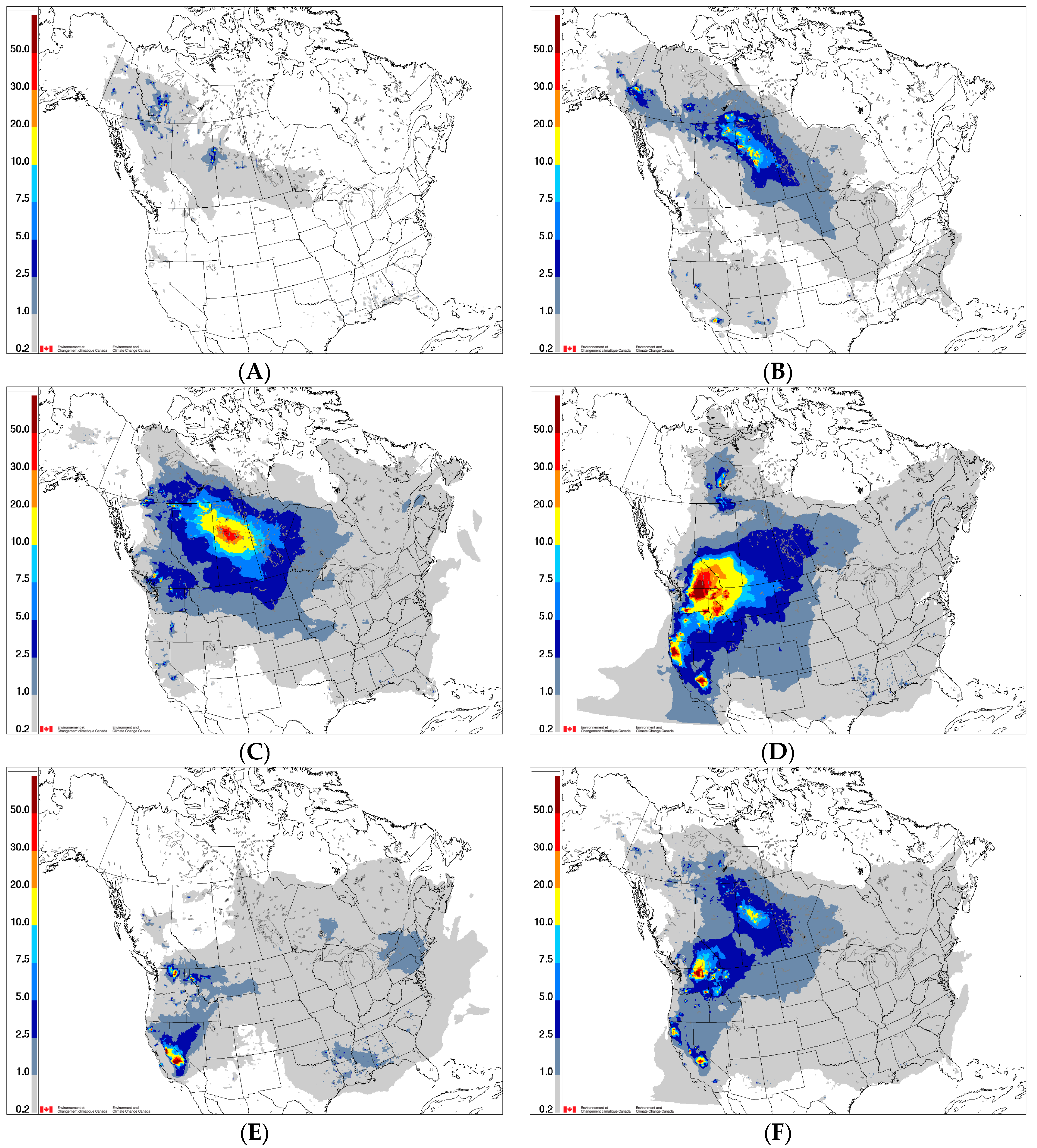
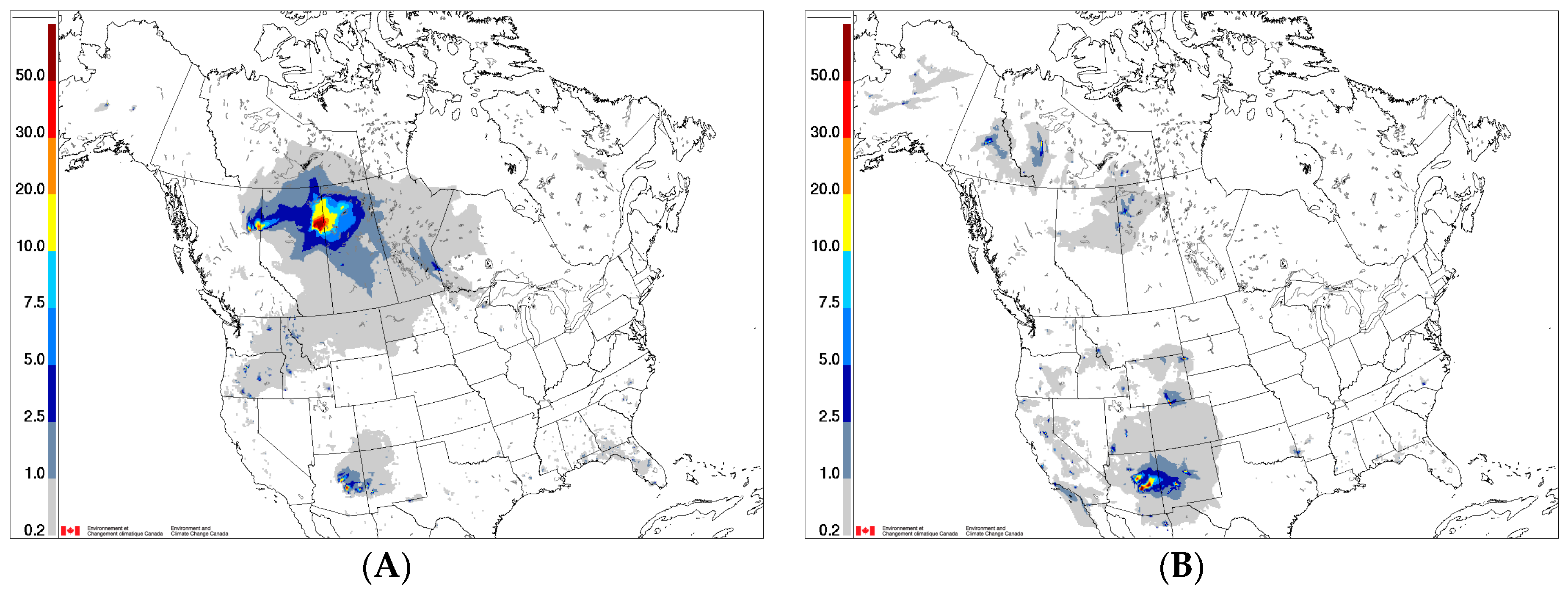
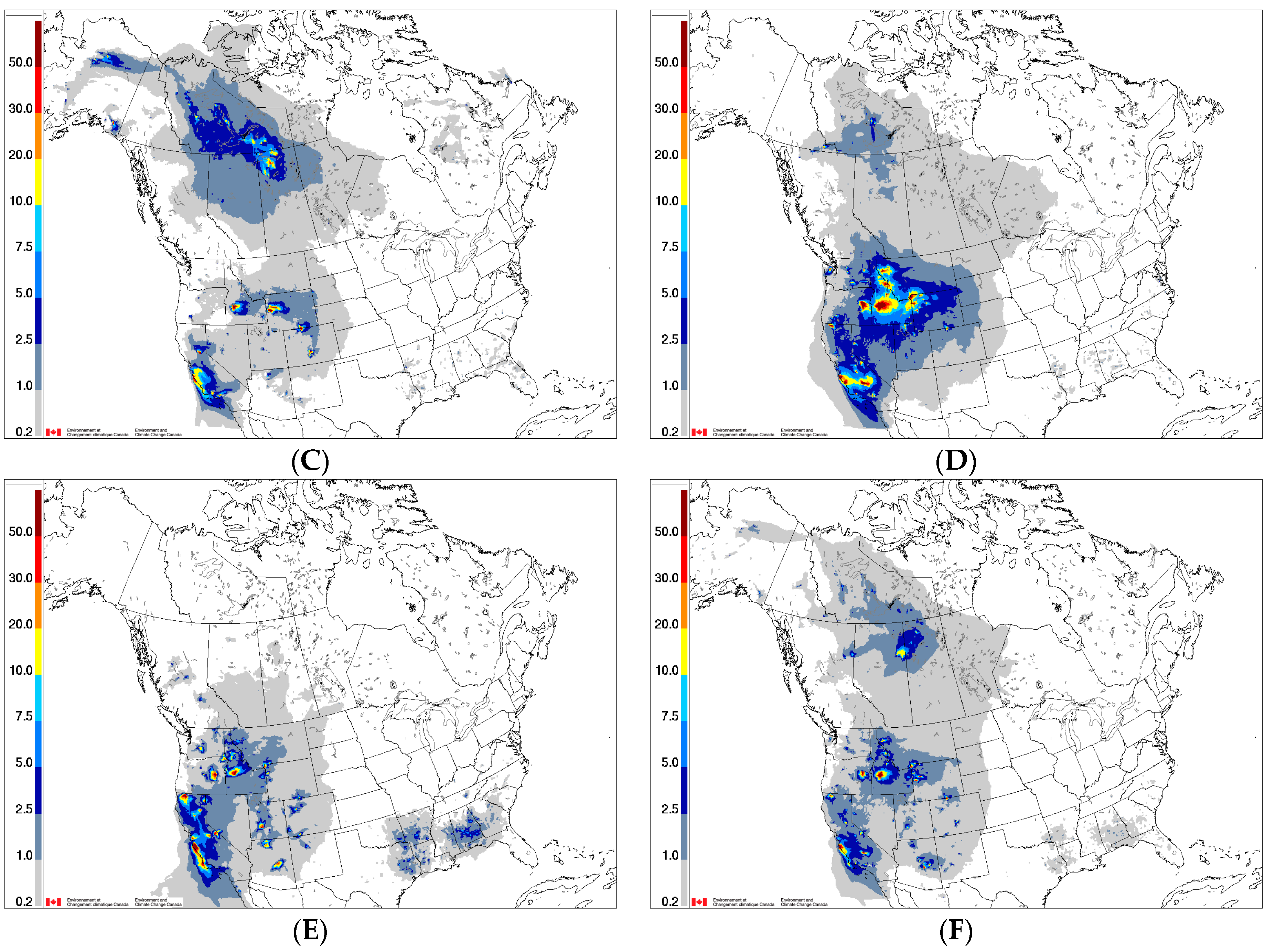
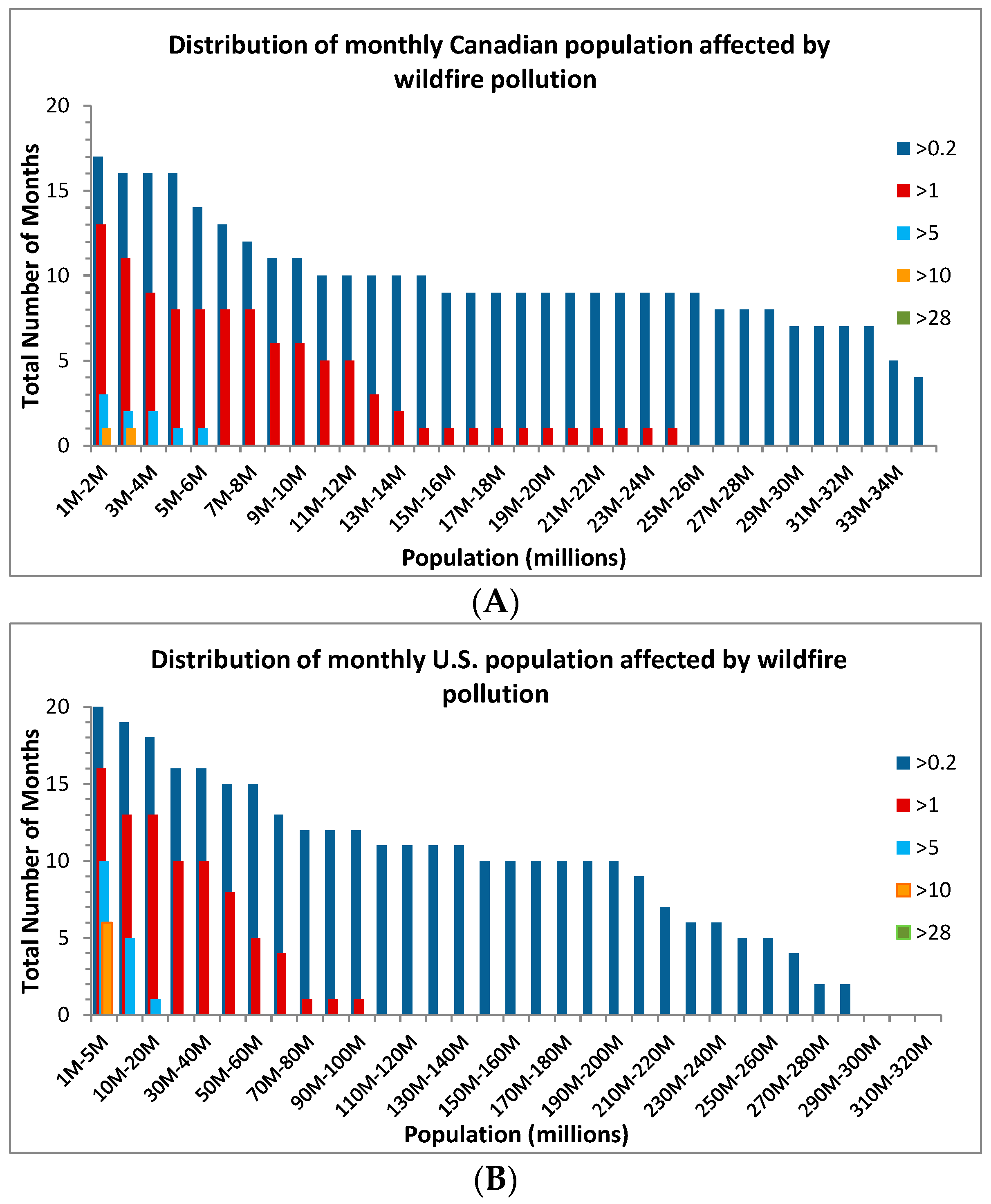
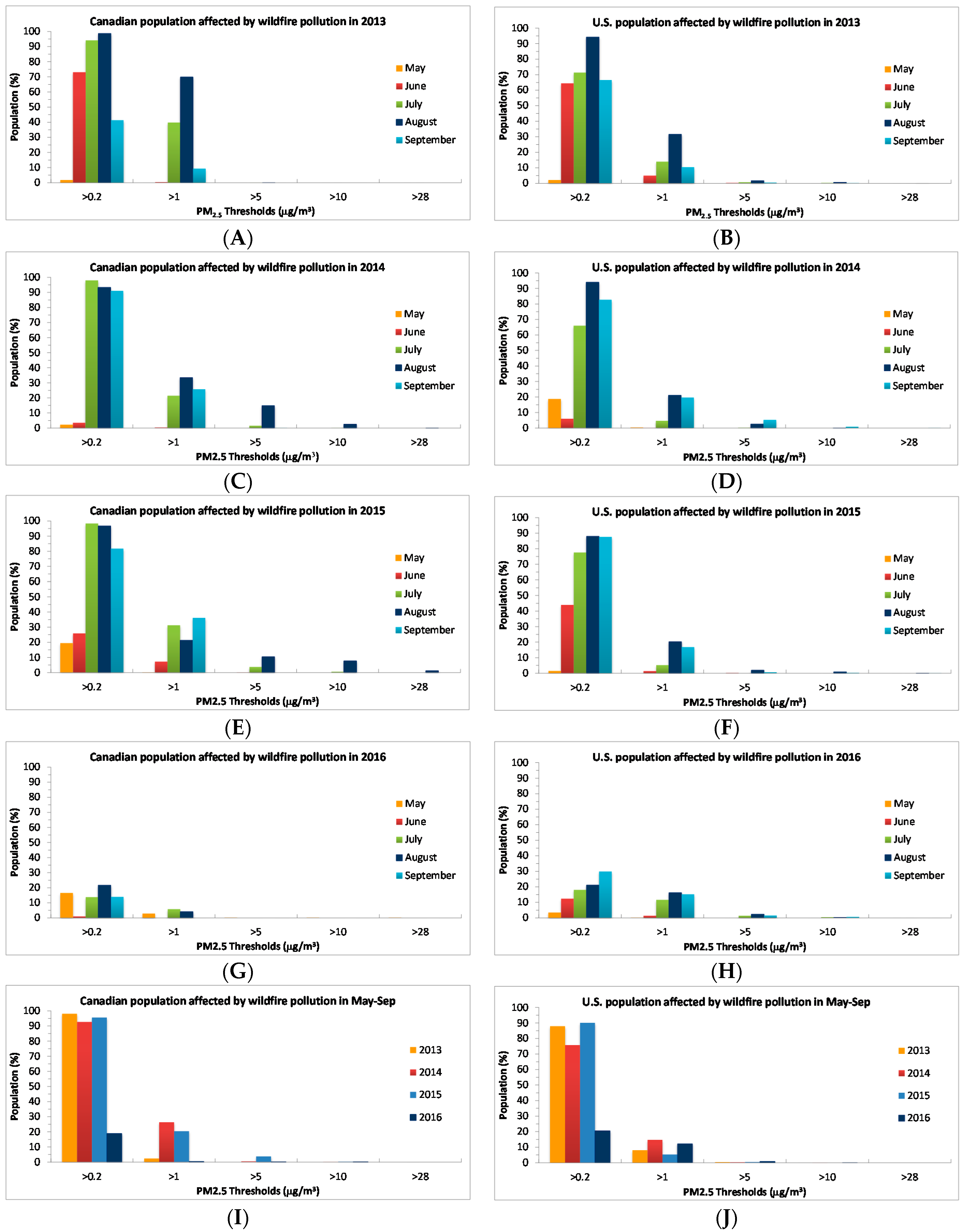


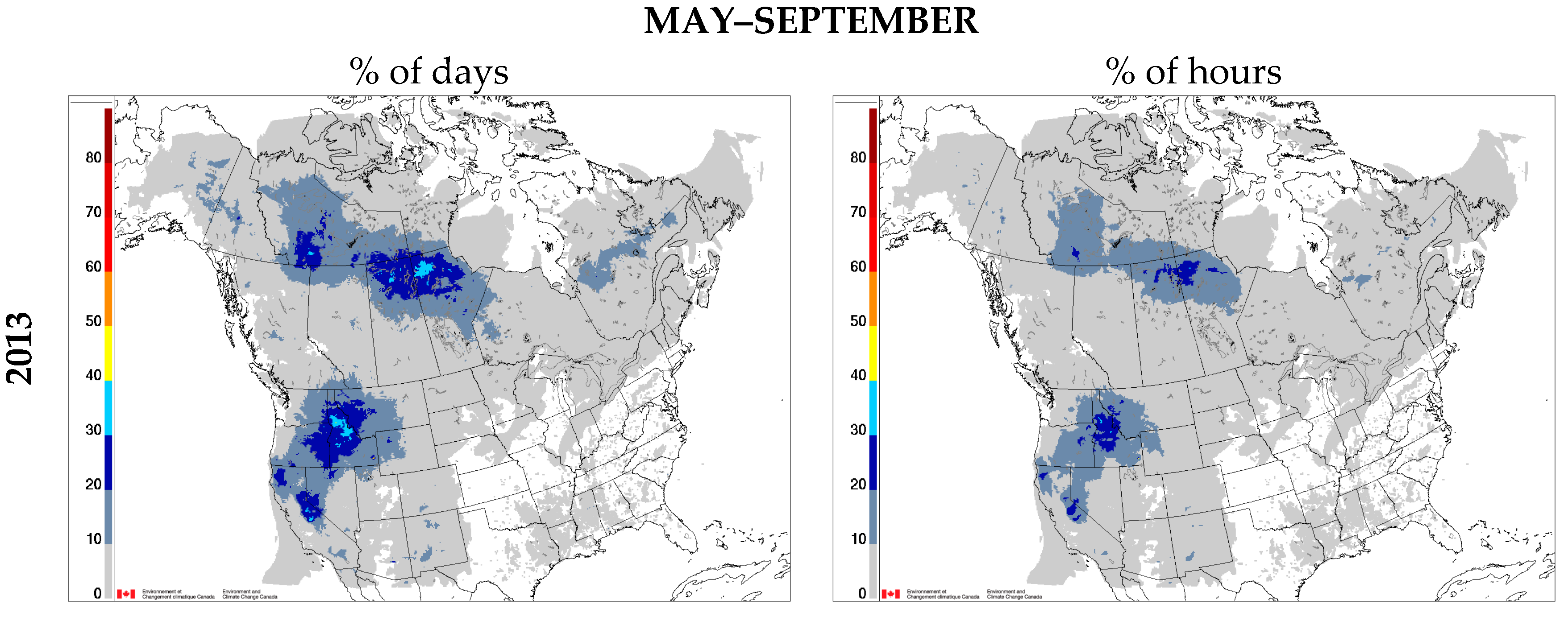
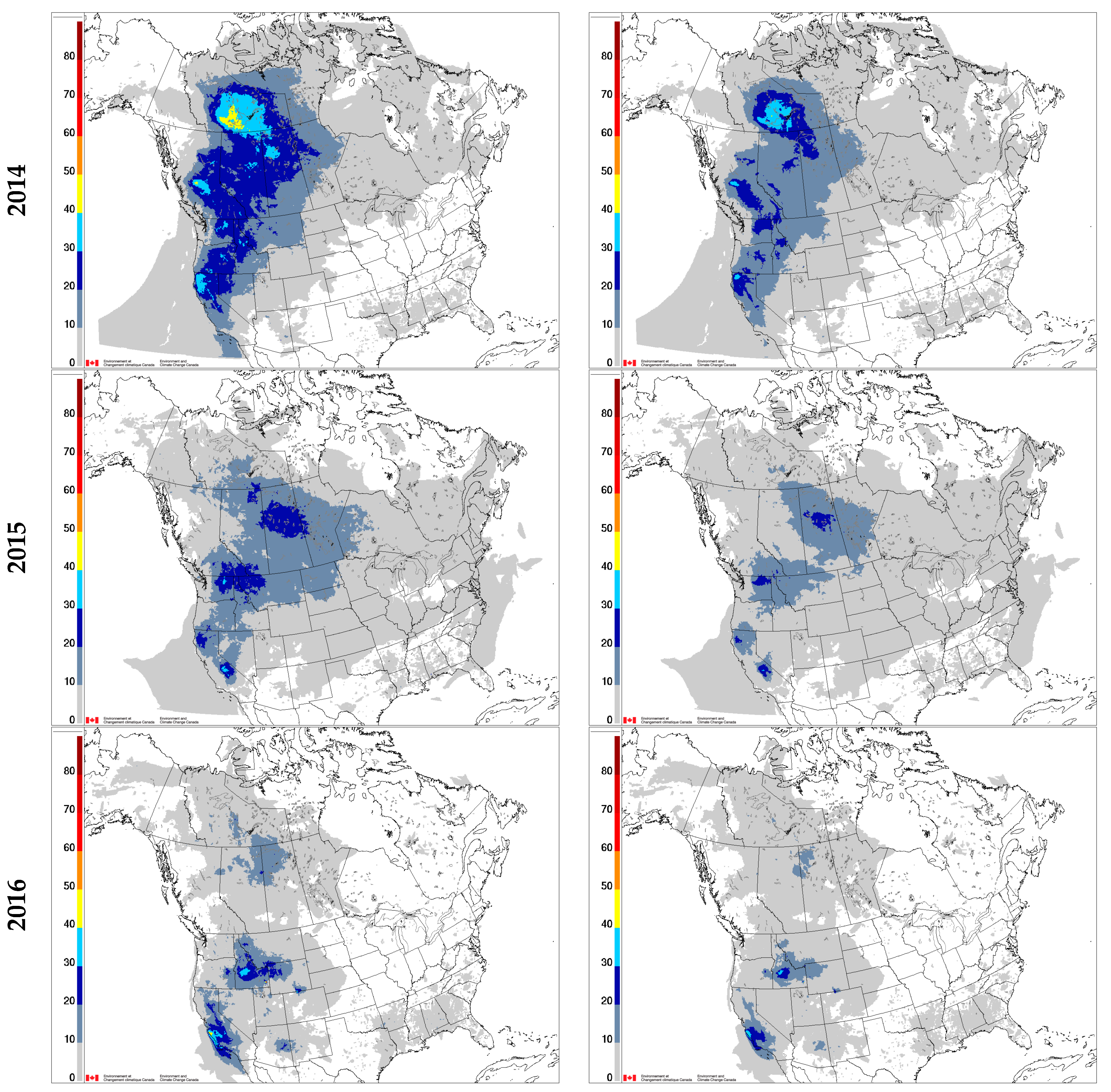
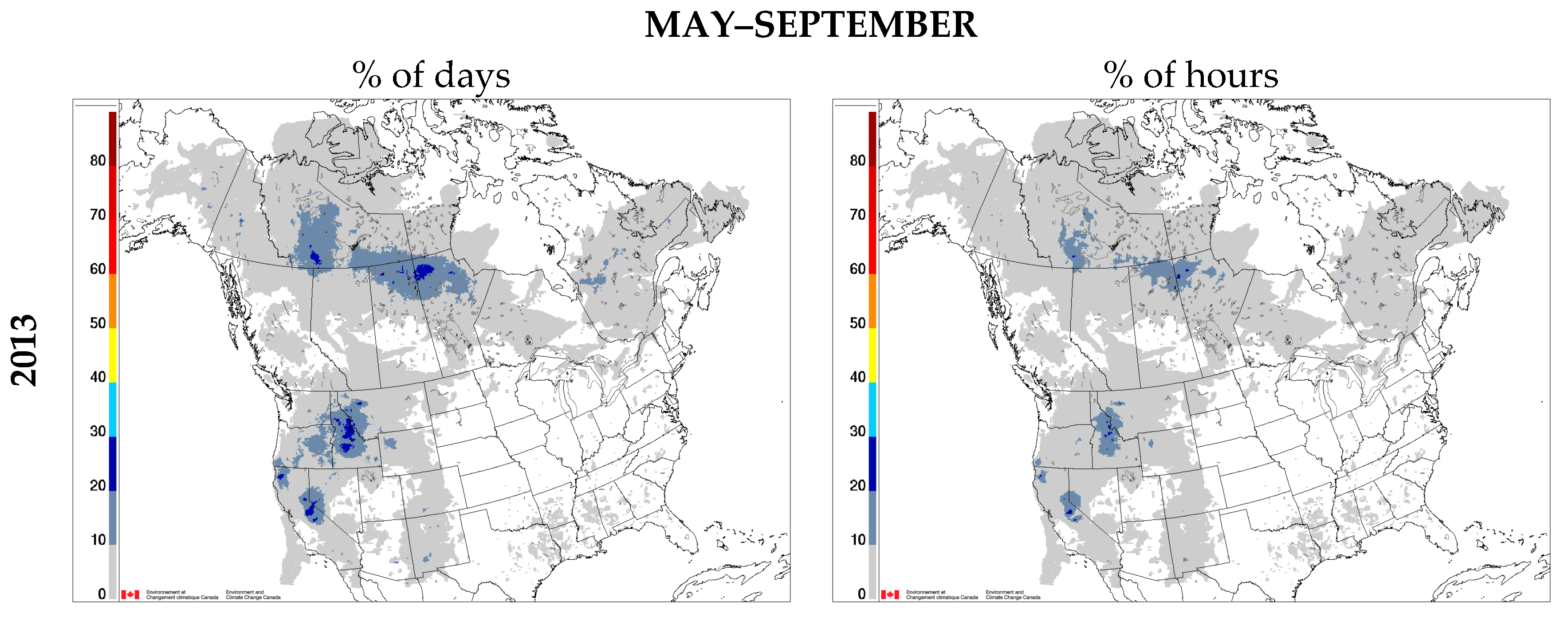
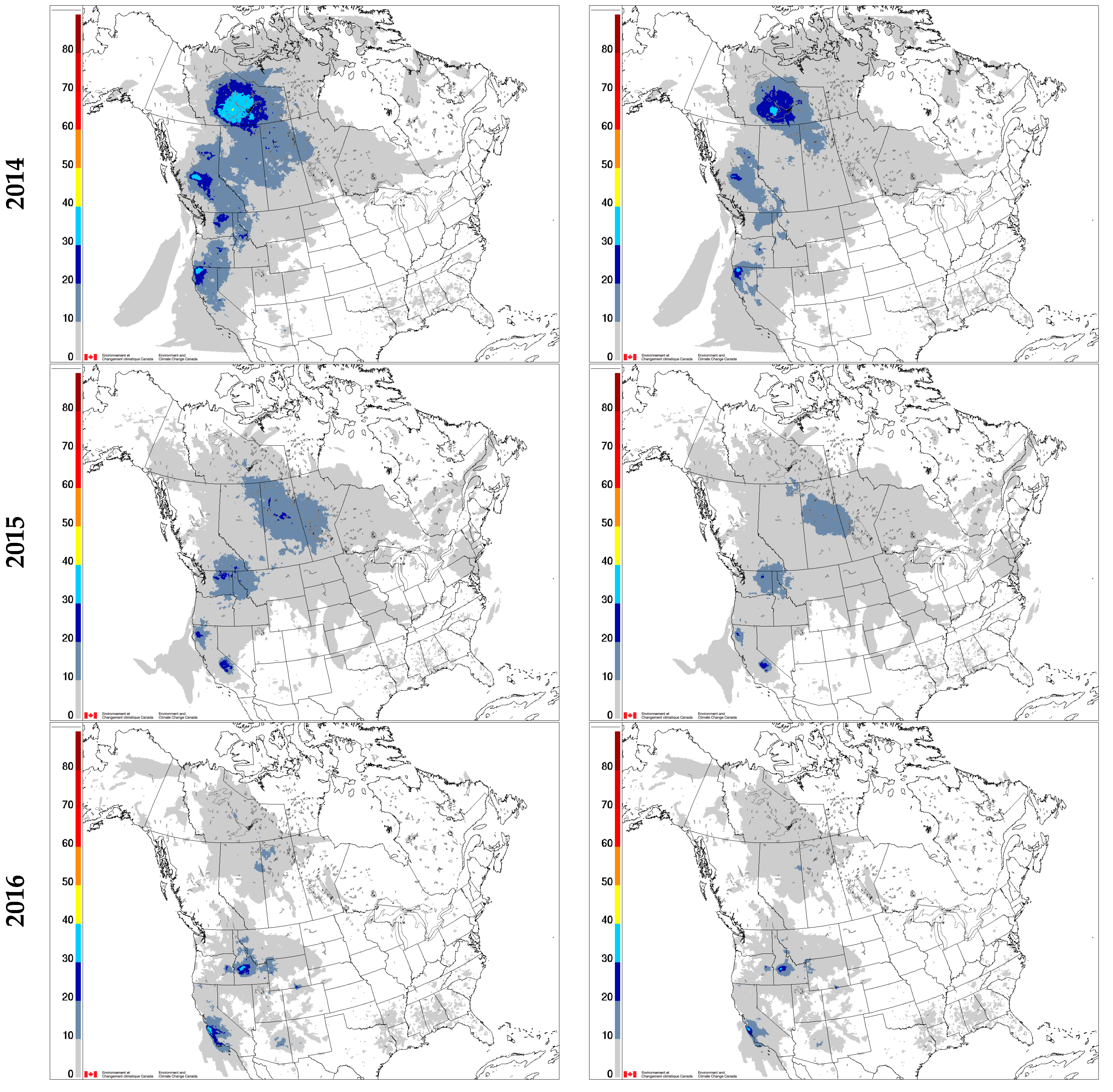
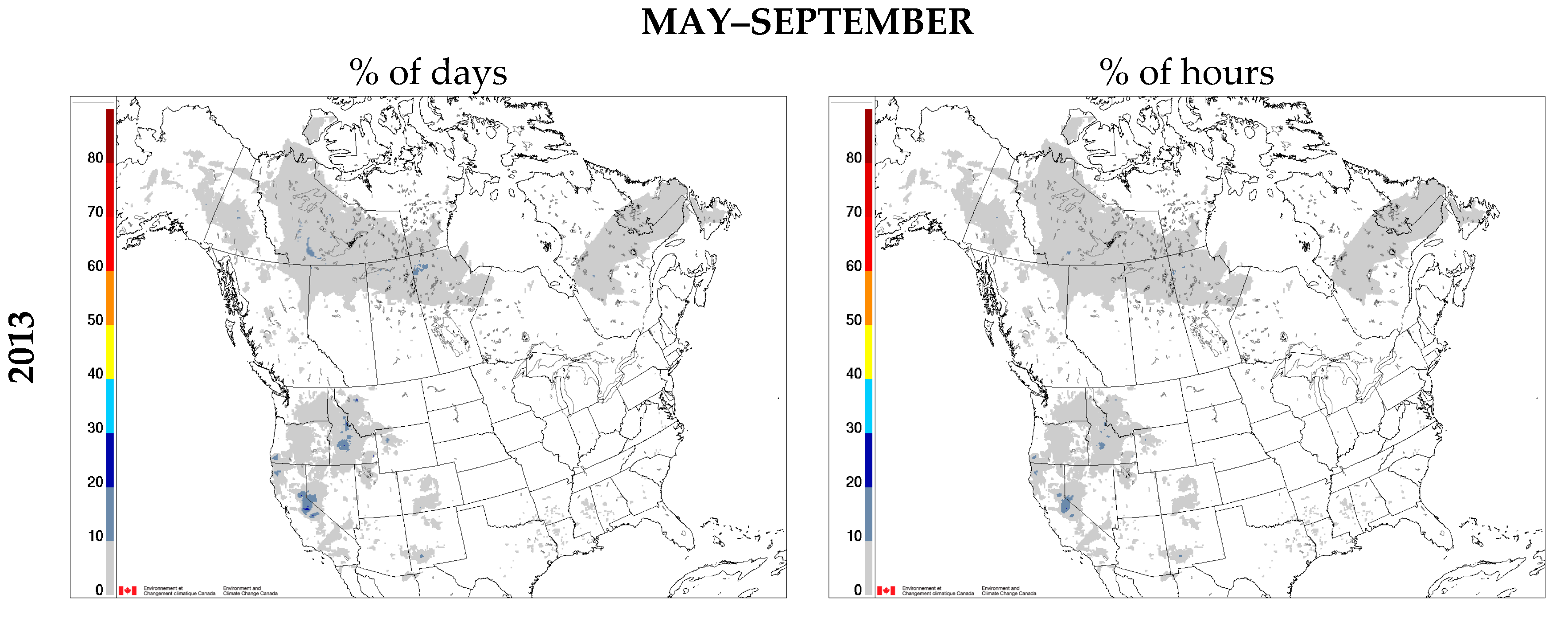
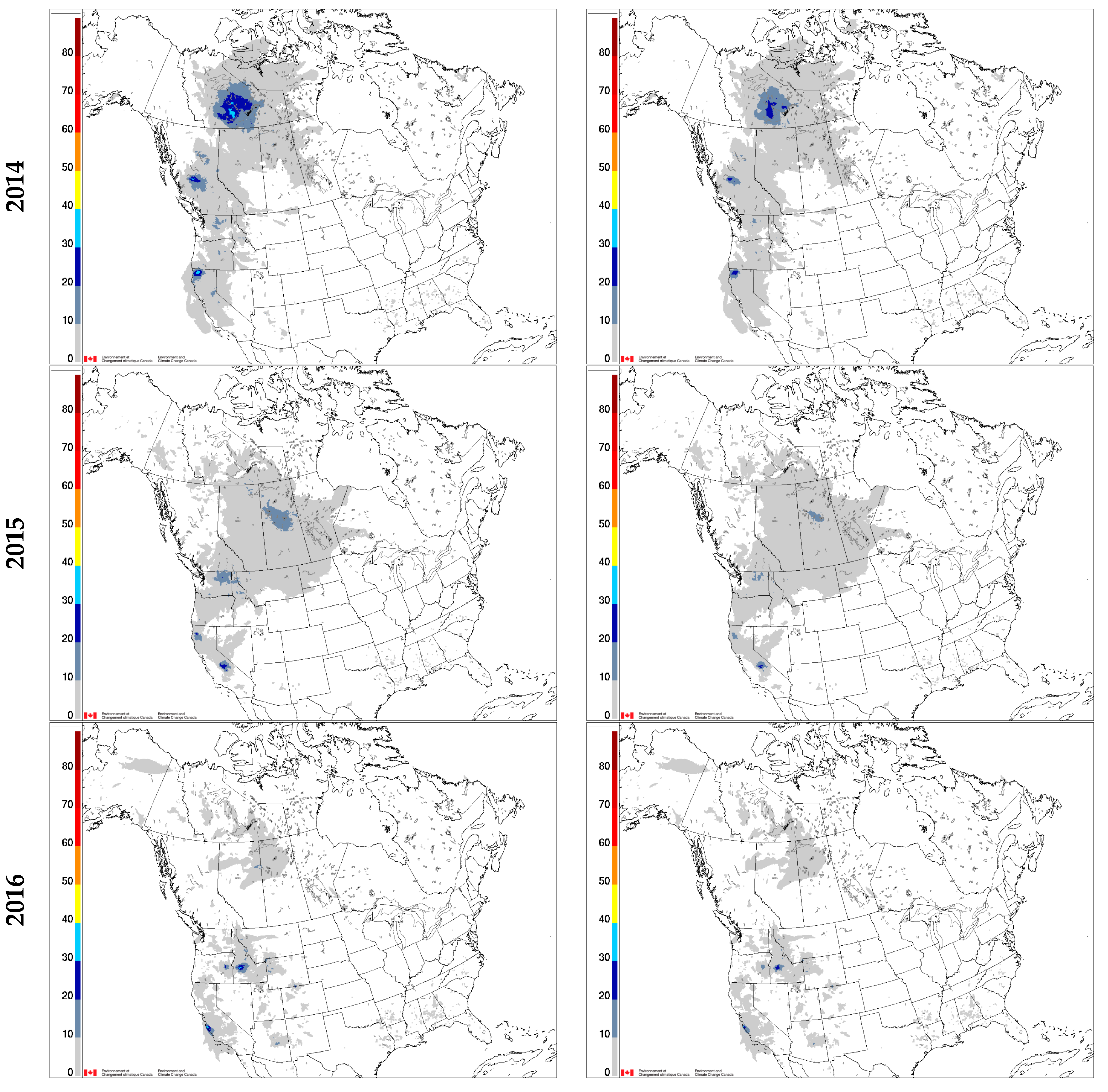
| Year | Experimental/Operational FireWork | Added Periods | |
|---|---|---|---|
| Start | End | ||
| 2013 | June 1 | August 31 | May 1‒31; Sep. 1‒31 |
| 2014 | June 9 | October 1 | May 1‒June 8 |
| 2015 | May 21 | October 31 | May 1‒20 |
| 2016 | April 1 | October 31 | ‒ |
| µg/m3 | >0.2 | >1 | >5 | >10 | >28 | |||||
|---|---|---|---|---|---|---|---|---|---|---|
| 2013 | ||||||||||
| May | 754,020 | (2.3%) | 30,662 | (0.1%) | 1377 | (0.0%) | 196 | (0.0%) | 0 | (0.0%) |
| June | 12,478,900 | (37.7%) | 2,532,748 | (7.7%) | 184,058 | (0.6%) | 48,991 | (0.1%) | 7378 | (0.0%) |
| July | 17,235,170 | (52.1%) | 7,279,618 | (22.0%) | 861,986 | (2.6%) | 194,966 | (0.6%) | 13,326 | (0.0%) |
| August | 20,155,062 | (60.9%) | 9,873,087 | (29.8%) | 1,783,453 | (5.4%) | 604,476 | (1.8%) | 71,844 | (0.2%) |
| September | 9,351,929 | (28.3%) | 2,072,752 | (6.3%) | 84,693 | (0.3%) | 39,022 | (0.1%) | 10,611 | (0.0%) |
| 2014 | ||||||||||
| May | 1,746,428 | (5.3%) | 61,310 | (0.2%) | 6507 | (0.0%) | 2137 | (0.0%) | 200 | (0.0%) |
| June | 3,411,109 | (10.3%) | 872,761 | (2.6%) | 57,926 | (0.2%) | 13,461 | (0.0%) | 1686 | (0.0%) |
| July | 16,196,537 | (49.0%) | 7,260,984 | (21.9%) | 1,562,298 | (4.7%) | 541,468 | (1.6%) | 146,616 | (0.4%) |
| August | 19,536,859 | (59.0%) | 8,436,851 | (25.5%) | 2,560,671 | (7.7%) | 934,005 | (2.8%) | 157,462 | (0.5%) |
| September | 13,305,055 | (40.2%) | 4,531,984 | (13.7%) | 444,316 | (1.3%) | 137,840 | (0.4%) | 24,680 | (0.1%) |
| 2015 | ||||||||||
| May | 2,837,325 | (8.6%) | 252,707 | (0.8%) | 12,768 | (0.0%) | 2950 | (0.0%) | 197 | (0.0%) |
| June | 9,375,291 | (28.3%) | 2,604,739 | (7.9%) | 291,593 | (0.9%) | 42,184 | (0.1%) | 2552 | (0.0%) |
| July | 14,245,102 | (43.1%) | 5,173,825 | (15.6%) | 1,033,576 | (3.1%) | 306,687 | (0.9%) | 30,776 | (0.1%) |
| August | 15,581,769 | (47.1%) | 5,918,077 | (17.9%) | 1,236,416 | (3.7%) | 636,671 | (1.9%) | 143,120 | (0.4%) |
| September | 11,999,087 | (36.3%) | 1,629,073 | (4.9%) | 102,071 | (0.3%) | 45,570 | (0.1%) | 14,173 | (0.0%) |
| 2016 | ||||||||||
| May | 3,829,030 | (11.6%) | 972,851 | (2.9%) | 167,935 | (0.5%) | 58,168 | (0.2%) | 11,955 | (0.0%) |
| June | 2,532,347 | (7.7%) | 334,211 | (1.0%) | 35,392 | (0.1%) | 13,575 | (0.0%) | 3599 | (0.0%) |
| July | 7,866,765 | (23.8%) | 2,709,907 | (8.2%) | 223,084 | (0.7%) | 57,209 | (0.2%) | 8215 | (0.0%) |
| August | 7,807,827 | (23.6%) | 2,839,017 | (8.6%) | 477,835 | (1.4%) | 146,340 | (0.4%) | 31,658 | (0.1%) |
| September | 4,914,590 | (14.9%) | 1,715,135 | (5.2%) | 204,326 | (0.6%) | 71,075 | (0.2%) | 15,620 | (0.0%) |
| Seasonal Exceedances (Area) | ||||||||||
| 2013 | 17,151,407 | (51.8%) | 4,534,747 | (13.7%) | 269,933 | (0.8%) | 62,226 | (0.2%) | 9267 | (0.0%) |
| 2014 | 16,335,869 | (49.4%) | 5,616,429 | (17.0%) | 625,489 | (1.9%) | 216,897 | (0.7%) | 28,417 | (0.1%) |
| 2015 | 14,507,744 | (43.8%) | 4,203,396 | (12.7%) | 373,565 | (1.1%) | 90,825 | (0.3%) | 16,248 | (0.0%) |
| 2016 | 7,229,006 | (21.8%) | 1,931,583 | (5.8%) | 121,897 | (0.4%) | 40,841 | (0.1%) | 9388 | (0.0%) |
© 2017 by the authors. Licensee MDPI, Basel, Switzerland. This article is an open access article distributed under the terms and conditions of the Creative Commons Attribution (CC BY) license (http://creativecommons.org/licenses/by/4.0/).
Share and Cite
Munoz-Alpizar, R.; Pavlovic, R.; Moran, M.D.; Chen, J.; Gravel, S.; Henderson, S.B.; Ménard, S.; Racine, J.; Duhamel, A.; Gilbert, S.; et al. Multi-Year (2013–2016) PM2.5 Wildfire Pollution Exposure over North America as Determined from Operational Air Quality Forecasts. Atmosphere 2017, 8, 179. https://doi.org/10.3390/atmos8090179
Munoz-Alpizar R, Pavlovic R, Moran MD, Chen J, Gravel S, Henderson SB, Ménard S, Racine J, Duhamel A, Gilbert S, et al. Multi-Year (2013–2016) PM2.5 Wildfire Pollution Exposure over North America as Determined from Operational Air Quality Forecasts. Atmosphere. 2017; 8(9):179. https://doi.org/10.3390/atmos8090179
Chicago/Turabian StyleMunoz-Alpizar, Rodrigo, Radenko Pavlovic, Michael D. Moran, Jack Chen, Sylvie Gravel, Sarah B. Henderson, Sylvain Ménard, Jacinthe Racine, Annie Duhamel, Samuel Gilbert, and et al. 2017. "Multi-Year (2013–2016) PM2.5 Wildfire Pollution Exposure over North America as Determined from Operational Air Quality Forecasts" Atmosphere 8, no. 9: 179. https://doi.org/10.3390/atmos8090179





